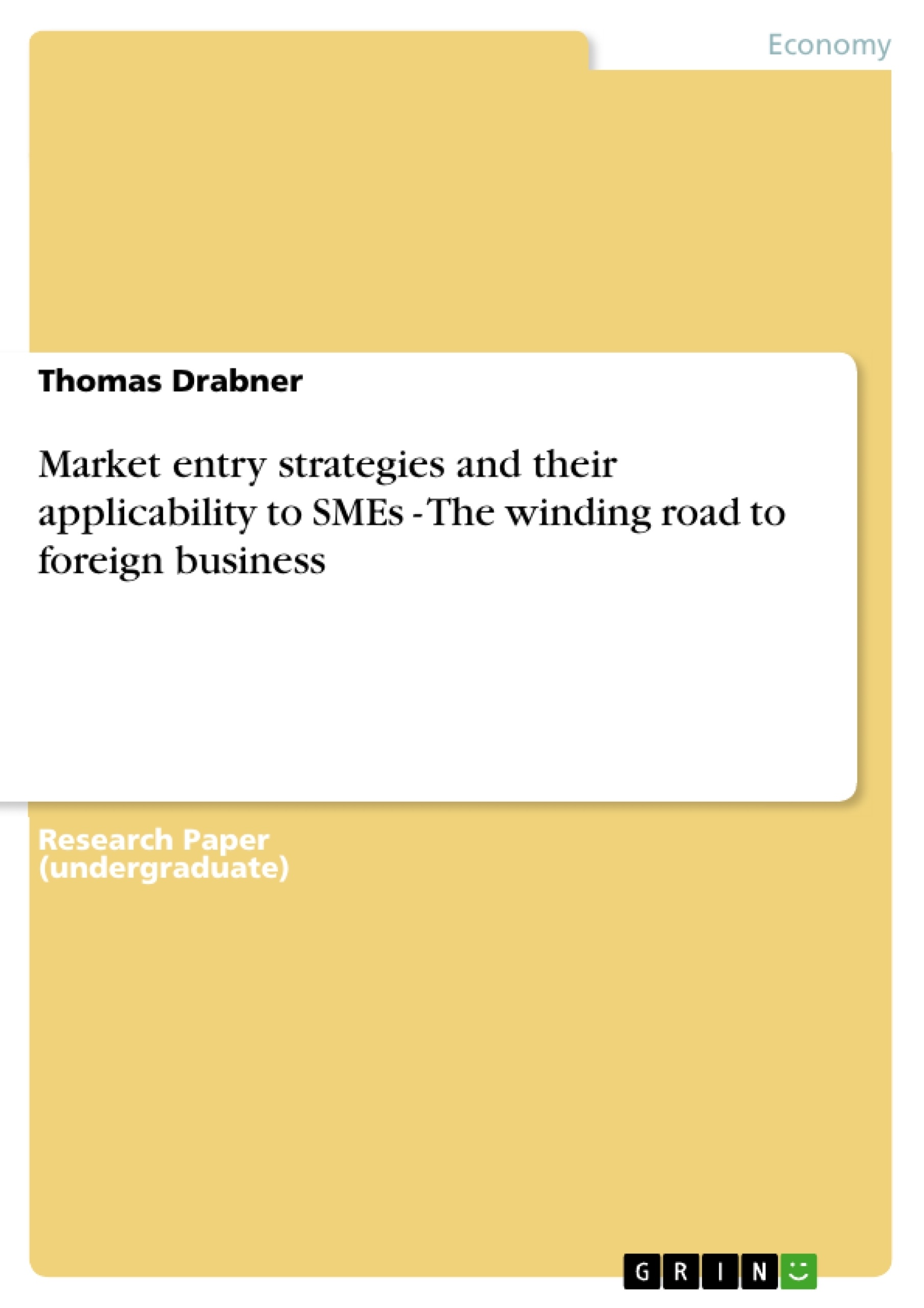“There will be hunters and hunted, winners and losers. What counts in global
competition is the right strategy and success.”
Heinrich von Pierer1
In business planning the globalization of the world market and the limits of
domestic growth raise the question to what extent a foreign commitment should
be considered if at all.2
In Germany these considerations are particularly underlined by the strong
integration into the world economy. German enterprises obtain a third of their
total revenue in foreign business, 25 % of all jobs depend on foreign trade.3
Contrary to expectations, going global is no longer subject only to large multinational
companies. Due to saturation tendencies in the domestic market,
global competition and the dependency on international key-account customers
small and medium-sized enterprises (SMEs) have been faced with the need for
international activities. 4
Considering the fact that SMEs account for 97,3 % of all German enterprises,
generating almost 45 % of the total revenue per year, the importance of future
growth potential becomes evident.5 In general, SMEs are referred to as the
“backbone” of German economy and many of them, the so called “hidden
champions” have successfully faced the challenge of entering foreign markets.6
Others have been afraid to take this step. For these, the need for adaptation
remains and their continuity will depend on the competitiveness in the world
market. In general, entering new markets is connected with a multiplicity of chances and
risks. SMEs especially, tend to underestimate the importance of profound
information and the need for a realistic estimation of own capabilities.7
Accordingly, it becomes necessary to focus on a SME specific approach which
considers major evaluation criteria for carefully developing market entry
strategies.
1 Dr. Heinrich von Pierer, President and Chief Excecutive Officer of Siemens AG:
Quotation cp. ‘TheGlobalist’ (2000)
2 cp. Hoppen (1999:144)
3 cp. Statistisches Bundesamt (2001:1.6)
4 Due to the IFM in Bonn (2000) SMEs intend to increase their foreign sales from an actual
average of 30 % to 50 % in 2020
5 cp. IMF Bonn (2000)
6 cp. Hibbert (2000:1)
7 cp. Brenner (1999:2 et sqq.)
Inhaltsverzeichnis (Table of Contents)
- Introduction
- Problem Formulation
- Purpose
- Approach
- Definitions
- SME Characteristics
- Management & Structure
- Experience & Knowledge
- Finances
- Evaluation criteria and entry modes – A basic framework
- Internal aspects
- Objectives
- Geographic expansion
- Concentric Strategy
- Regiocentric Strategy
- Global Strategy
- Timing
- Pioneer Strategy
- Follower Strategy
- External aspects
- Market Potential
- Market Barriers
- Competition
- Derivation of market entry modes
- Export
- Licensing
- Joint Venture
- Direct investment
- Internal aspects
Zielsetzung und Themenschwerpunkte (Objectives and Key Themes)
This study aims to analyze the applicability of market entry strategies for small and medium-sized enterprises (SMEs). The research focuses on the challenges and opportunities faced by SMEs when expanding into foreign markets, examining the factors that influence their choices of entry modes.
- Market entry strategies for SMEs
- Evaluation criteria for selecting entry modes
- Internal and external factors influencing market entry decisions
- Applicability of different entry modes to SMEs
- The impact of SME characteristics on market entry success
Zusammenfassung der Kapitel (Chapter Summaries)
- Introduction: Introduces the study's purpose and outlines the problem formulation. It defines key terms and concepts related to market entry and SMEs.
- SME Characteristics: Examines the defining characteristics of SMEs, including their management structures, experience, and financial resources. This chapter explores how these factors influence their ability to pursue foreign market expansion.
- Evaluation criteria and entry modes – A basic framework: Establishes a framework for analyzing market entry strategies. It examines both internal and external factors that influence entry mode decisions, including company objectives, geographic expansion strategies, timing considerations, market potential, barriers, and competition. This chapter also presents an overview of different market entry modes, such as export, licensing, joint ventures, and direct investment.
Schlüsselwörter (Keywords)
The study focuses on the following keywords: market entry strategies, SMEs, international business, entry modes, evaluation criteria, internal factors, external factors, export, licensing, joint ventures, direct investment, geographic expansion, timing, market potential, market barriers, competition.
- Citar trabajo
- Thomas Drabner (Autor), 2003, Market entry strategies and their applicability to SMEs - The winding road to foreign business, Múnich, GRIN Verlag, https://www.grin.com/document/14026



